List of largest exoplanets
Topic: Astronomy
 From HandWiki - Reading time: 16 min
From HandWiki - Reading time: 16 min
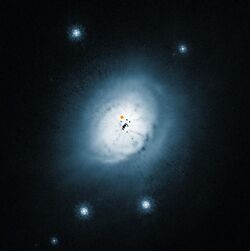
Below is a list of the largest exoplanets so far discovered, in terms of physical size, ordered by radius.
Caveats
This list of extrasolar objects may and will change over time because of inconsistency between journals, different methods used to examine these objects and the already extremely hard task of discovering exoplanets, or any other large objects for that matter. Then there is the fact that these objects might be brown dwarfs, sub-brown dwarfs, or not exist at all. Because of this, this list only cites the best measurements to date and is prone to change. Remember, these objects are not stars, and are quite small on a universal or even stellar scale.
List
The sizes are listed in units of Jupiter radii (71,492 km). All planets listed are larger than 1.7 times the size of the largest planet in the Solar System, Jupiter. Some planets that are smaller than 1.7 RJ have been included for the sake of comparison.
| Probably brown dwarfs (based on mass) | |
|---|---|
| Probably sub-brown dwarfs (based on mass and location) | |
| Probably planets (based on mass) |
| Image | Exoplanet name | Radius ([[Astronomy:Jupiter radius | J}}}}}}]]) | Notes |
|---|---|---|---|---|
| Size limit for brown dwarfs | 8[1] | |||
| Proplyd 133-353 | 7.4±0.3 – 8.0±1.1[2][lower-alpha 1] | A candidate rogue planet / sub-brown dwarf with a photoevaporating disk. It is located in the Orion Nebula Cluster. At 500,000 years old, it is one of the youngest exoplanets known.
More information about the exoplanet and estimates of its radius are available below: | ||

|
HD 100546 b | 3.4[3] | For the given radius, the object has a corresponding mass of 25 MJ. A separate numerical simulation gives 1.65 MJ.[4] (The original estimate for the radius is 6.9 [[Astronomy:Jupiter radius | J}}}}}}]].) It is a currently forming brown dwarf or planet. |

|
GQ Lupi b | 3.0±0.5,[5] 4.6±1.5,[6] 3.50+1.50−1.03,[7] 3.77[8] | 21.5 MJ; at the highest end of this range, it may be classified as a young brown dwarf. | |
| DH Tauri b | 2.6±0.7 – 2.7±0.8[9] 2.68[10] | 14.2 MJ; at its largest, it would be classified as a brown dwarf.[10] | ||
| ROXs 42Bb | 2.5[11] | This hot, massive planet (9+6−3 MJ) varies from 0.9 RJ to 3 RJ.[11] | ||

|
OTS 44 | Very likely a brown dwarf[12] or sub-brown dwarf,[13] which it may be the least massive free-floating substellar objects. It is surrounded by a circumstellar disk of dust and particles of rock and ice. | ||
| The above radii are larger than what planetary evolution theory predicts for hot Jupiters,
and are thus potentially unreliable. | ||||
| Hot Jupiter limit | 2.2[14] | Theoretical limit for hot Jupiters close to a star, that are limited by tidal heating, resulting in 'runaway inflation' | ||
| CT Chamaeleontis b | 2.2+0.81−0.6[15] | 17 MJ; is likely a brown dwarf. | ||
| TOI-3540 Ab | 2.1[16] | |||
| HAT-P-67b | 2.085+0.096−0.071[17] | 0.34+0.25−0.19 MJ; a very puffy Hot Jupiter | ||

|
XO-6b | 2.07±0.22[18] | 4.4 MJ; a very puffy Hot Jupiter | |
| HAT-P-41b | 2.05±0.50[5] | 1.19 MJ; a very puffy Hot Jupiter | ||
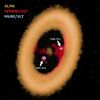
|
PDS 70 c | 2.04+0.61 −0.45[5] |
2 MJ | |
| HIP 65 Ab | 2.03+0.61 −0.49[5] |
3.213 MJ; a very puffy Hot Jupiter | ||

|
WASP-17b (Ditsö̀) | 1.991±0.081[19] | Was the largest known planet in 2012. At only 0.486 MJ, this Hot Jupiter is extremely low density at 0.08 g/cm3 which make it is one of the most puffy planet known. This estimate gives also a range from 1.411 RJ to 2.071 RJ.[20] | |

|
Kepler-435b | 1.99±0.18[21] | ||
| HAT-P-32b | 1.980±0.045,[5] 2.037±0.999[18] | 0.941 (± 0.166) MJ; a very puffy Hot Jupiter. Other estimates give 1.789±0.025 RJ.[22] | ||

|
WASP-12b | 1.937±0.056[23] 1.900+0.057−0.055,[24] 1.736±0.056[25] | This planet is so close to its parent star that its tidal forces are distorting it into an egg shape. As of September 2017, it has been described as "black as asphalt", and as a "pitch black" hot Jupiter as it absorbs 94% of the light that shines on its surface. | |

|
PDS 70 b | 1.93+0.26−0.08 - 2.72+0.39−0.34[26] | ||
| KELT-19 Ab | 1.91±0.11[27] | |||

|
51 Pegasi b (Dimidium/Bellerophon) | 1.9±0.3[28] | First exoplanet to be discovered orbiting a main-sequence star. Prototype hot Jupiter. | |

|
KELT-9b | 1.891+0.061−0.055[29] | The hottest confirmed exoplanet known. | |
| HAT-P-65b | 1.89±0.13[30] | |||
| TOI-1518 b | 1.875±0.053[5] | <2.3 MJ | ||
| HAT-P-70b | 1.87+0.15 −0.10[5] |
<6.78 MJ | ||

|
WASP-121b | 1.865±0.044[31] | ||
| HATS-23b | 1.86+0.3−0.4[32] | |||
| CFHTWIR-Oph 98 b | 1.86±0.05[5] | 7.8 MJ | ||
| KELT-8b | 1.86+0.18−0.16[33] | |||
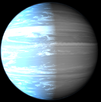
|
WASP-76b | 1.83+0.06−0.04[34] | The tidally-locked planet where winds move 18,000 km/h, and where molten iron rains from the sky due to daytime temperatures exceeding 2,400 °C (4,350 °F).[35][36] | |
| HAT-P-33b | 1.827±0.29,[37] 1.85±0.49[5] | |||
| File:First ever image of a multi-planet system around a Sun-like star.tif | TYC 8998-760-1 b | 1.82±0.08[38] – 3.0+0.2−0.7,[6] | On 22 July 2020, astronomers announced images, for the first-time, of multiple extrasolar bodies orbiting a star, TYC 8998-760-1, nearly identical to the Sun, except for age. TYC 8998-760-1 is only 27 Ma old while the Sun is 4,500 Ma.[39][40][41] and its largest orbital body (TYC 8998-760-1 b) is 22 ± 3 MJ; likely making it a brown dwarf. | |
| WASP-178b | 1.81±0.09[5] | 1.66 MJ | ||

|
Upsilon Andromedae b (Saffar) | 1.8[42] | ||

|
Cha 110913-773444 | A rogue planet (Likely a sub-brown dwarf) that is surrounded by a protoplanetary disk. It is one of youngest free-floating substellar objects with 0.5–10 Myr. | ||
| GSC 06214-00210 b | 1.8±0.5[5] | 16 MJ, likely brown dwarf | ||

|
TrES-4b | 1.799±0.063[43] | This planet has a density of 0.2 g/cm3, about that of balsa wood, less than Jupiter's 1.3g/cm3. | |
| WASP-122b | 1.792±0.069[44] | |||
| KELT-12b | 1.78+0.17−0.16[45] | |||
| TOI-640 b | 1.771+0.060 −0.056[5] |
0.88 MJ | ||
| TOI-2193 Ab | 1.77[46] | |||
| TOI-2669b | 1.76±0.16[47] | |||
| Kepler-12b | 1.754+0.031−0.036[48] | |||
| HATS-26b | 1.75±0.21[49] | |||
| KELT-14b | 1.743±0.047[44] | |||
| KELT-15b | 1.74±0.20[5] | 1.31 MJ | ||
| HAT-P-57b | 1.74±0.36[5] | 1.41 MJ | ||
| KELT-20b | 1.735+0.07−0.075,[50] 1.741+0.069 −0.074[5] |
|||
| HAT-P-64b | 1.703±0.070[5] | 0.58 MJ | ||
| WASP-78b | 1.70±0.04,[51] 1.93±0.45[5] | |||
| Qatar-7b | 1.70±0.03[5] | 1.88 MJ | ||
| A few additional examples with radii lower than 1.7 [[Astronomy:Jupiter radius | J}}}}}}]]. | |||
| KELT-4Ab | 1.699+0.046 −0.045,[5] 1.706+0.085−0.076[52] |
|||
| Kepler-12b | 1.695+0.032−0.032,[53] 1.754+0.031 −0.036[5] |
|||
| WASP-79b (Pollera) | 1.67±0.15,[5] 2.09±0.14[51] | |||
| 1RXS 1609b | 1.664,[5] 1.7[54] | 14+2.0−3.0 MJ; is likely a brown dwarf. | ||

|
Beta Pictoris b | 1.65 | Likely the second most massive object in its namesake system. | |
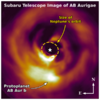
|
AB Aurigae b | 2.75;[55] 1.6[56] | ||
| WASP-94 Ab | 1.58±0.13,[5] 1.72+0.06−0.05[57] | |||

|
PSO J318.5−22 | 1.53 | An extrasolar object that does not seem to be orbiting any stellar mass, see: rogue planet. | |
| HAT-P-40b (Vytis) | 1.52±0.17,[5] 1.730±0.062[58] | |||
| Kepler-13 Ab (KOI-13b) | 1.512±0.035,[5] 2.216±0.087[59] | Esteves et al. gives also radii of 1.512±0.035 RJ and 2.63+1.04−0.82 RJ. Batalha et al. calculate 2.03 RJ.[60] | ||

|
Kepler-7b | 1.478 | ||
| WASP-88b | 1.46±0.21,[5] 1.7+0.13−0.07[61] | |||
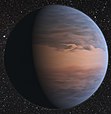
|
HD 209458 b | 1.35 | The first exoplanet whose size was determined. Named after a prominent Egyptian deity, 'Osiris'. | |
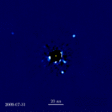
|
HR 8799 c | 1.3[62] | ||
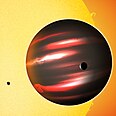
|
TrES-2b (Kepler-1b) | 1.272 | Darkest known exoplanet due to an extremely low geometric albedo. It absorbs 99% of light. | |
| HD 100546 c | 1.265[63] | Still disputed. | ||
| Kepler-39b | 1.22 | One of the most massive exoplanets known. | ||

|
HR 8799 d | 1.2[64] | ||

|
HR 8799 b | 1.2[64] | ||

|
HR 8799 e | 1.17[65] | ||
| COCONUTS-2b | 1.12±0.04 | The exoplanet with the longest orbital period, of 1100000 years (around one megannum). It is located 7,506 astronomical units (0.11869 ly) from its star. | ||
| HR 2562 b | 1.11 | Most massive planet with a mass of 30 MJ, although according to most definitions of planet, it may be too massive to be a planet, and may be a brown dwarf instead. | ||

|
HIP 11915 b | 1[66] | This exoplanet is an analogue to Jupiter, having a similar radius, mass and temperature, and it is orbiting a star analogous to the Sun. | |
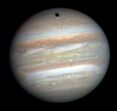
|
Jupiter | 1
69,911 km[67] |
Largest planet in the Solar System, by radius and mass.[68] Reported for reference. | |
See also
- List of smallest exoplanets
- List of largest cosmic structures
- List of largest galaxies
- List of largest nebulae
- List of largest known stars
- Lists of astronomical objects
- List of most massive stars
Notes
- ↑ Based on the estimated temperature and luminosity.
- ↑ Using PMS evolutionary models and a potential higher age of 1 Myr, the luminosity would be lower, and the planet would be smaller. However, this would require for the object to be closer as well, which is unlikely. Another distance estimate to the Orion Nebula Cluster would result in a luminosity 1.14 times lower and also a smaller radius.[2]
- ↑ 'Instead of a photo-evaporating disk it may be an evaporating gaseous globule (EGG)'. If so, it has a mass of 2 - 28 MJ.[2]
- ↑ A calculated radius thus does not need to be the radius of the (dense) core.
References
- ↑ Chabrier, G.; Johansen, A.; Janson, M.; Rafikov, R. (2014). "Giant Planet and Brown Dwarf Formation". Protostars and Planets VI. doi:10.2458/azu_uapress_9780816531240-ch027. ISBN 9780816531240.
- ↑ 2.0 2.1 2.2 Fang, Min; Kim, Jinyoung Serena; Pascucci, Ilaria; Apai, Dániel; Manara, Carlo Felice (2016-12-12). "A candidate planetary-mass object with a photoevaporating disk in Orion". The Astrophysical Journal 833 (2): L16. doi:10.3847/2041-8213/833/2/L16. ISSN 2041-8213. Bibcode: 2016ApJ...833L..16F.
- ↑ Sissa, Elena (2017-07-01). Observation of extrasolar planets at various ages (Thesis). Bibcode:2017PhDT.......406S.
- ↑ Pineda, Jaime E.; Szulágyi, Judit; Quanz, Sascha P.; van Dishoeck, Ewine F.; Garufi, Antonio; Meru, Farzana; Mulders, Gijs D.; Testi, Leonardo et al. (2019-01-21). "High-resolution ALMA Observations of HD 100546: Asymmetric Circumstellar Ring and Circumplanetary Disk Upper Limits". The Astrophysical Journal 871 (1): 48. doi:10.3847/1538-4357/aaf389. ISSN 1538-4357. Bibcode: 2019ApJ...871...48P.
- ↑ 5.00 5.01 5.02 5.03 5.04 5.05 5.06 5.07 5.08 5.09 5.10 5.11 5.12 5.13 5.14 5.15 5.16 5.17 5.18 5.19 5.20 5.21 5.22 5.23 5.24 5.25 "Planetary Systems Composite Data". https://exoplanetarchive.ipac.caltech.edu/cgi-bin/TblView/nph-tblView?app=ExoTbls&config=PSCompPars. Retrieved 12 December 2021.
- ↑ 6.0 6.1 "The Extrasolar Planet Encyclopaedia - Catalog Listing". Extrasolar Planets Encyclopaedia. 1995. https://exoplanet.eu/catalog/.
- ↑ Seifahrt, A.; Neuhäuser, R.; Hauschildt, P. H. (2007-02-01). "Near-infrared integral-field spectroscopy of the companion to GQ Lupi". Astronomy & Astrophysics 463 (1): 309–313. doi:10.1051/0004-6361:20066463. ISSN 0004-6361. Bibcode: 2007A&A...463..309S. http://www.aanda.org/10.1051/0004-6361:20066463.
- ↑ Stolker, Tomas; Haffert, Sebastiaan Y.; Kesseli, Aurora Y.; van Holstein, Rob G.; Aoyama, Yuhiko; Brinchmann, Jarle; Cugno, Gabriele; Girard, Julien H. et al. (2021-12-01). "Characterizing the Protolunar Disk of the Accreting Companion GQ Lupi B*". The Astronomical Journal 162 (6): 286. doi:10.3847/1538-3881/ac2c7f. ISSN 0004-6256. Bibcode: 2021AJ....162..286S.
- ↑ Zhou, Yifan; Herczeg, Gregory J; Kraus, Adam L; Metchev, Stanimir; Cruz, Kelle L (2014). "Accretion onto Planetary Mass Companions of Low-mass Young Stars". The Astrophysical Journal Letters 783 (1): L17. doi:10.1088/2041-8205/783/1/L17. Bibcode: 2014ApJ...783L..17Z.
- ↑ 10.0 10.1 Xuan, Jerry W.; Bryan, Marta L.; Knutson, Heather A.; Bowler, Brendan P.; Morley, Caroline V.; Benneke, Björn (2020-02-10). "A Rotation Rate for the Planetary-Mass Companion DH Tau b". The Astronomical Journal 159 (3): 97. doi:10.3847/1538-3881/ab67c4. ISSN 1538-3881. Bibcode: 2020AJ....159...97X.
- ↑ 11.0 11.1 Currie, Thayne; Burrows, Adam; Daemgen, Sebastian (2014). "A First-Look Atmospheric Modeling Study of the Young Directly-Imaged Planet-Mass Companion, ROXs 42Bb". The Astrophysical Journal 787 (2): 104. doi:10.1088/0004-637X/787/2/104. Bibcode: 2014ApJ...787..104C.
- ↑ Cite error: Invalid
<ref>tag; no text was provided for refs namedapj620_1_L51 - ↑ Cite error: Invalid
<ref>tag; no text was provided for refs namedjoergens2013_AA558 - ↑ Hou, Qiang; Wei, Xing (2022). "Why hot Jupiters can be large but not too large". Monthly Notices of the Royal Astronomical Society 511 (3): 3133–3137. doi:10.1093/mnras/stac169.
- ↑ Schmidt, T. O. B.; Neuhäuser, R.; Seifahrt, A.; Vogt, N.; Bedalov, A.; Helling, Ch.; Witte, S.; Hauschildt, P. H. (2008). "Direct evidence of a sub-stellar companion around CT Chamaeleontis". Astronomy & Astrophysics 491 (1): 311–320. doi:10.1051/0004-6361:20078840. Bibcode: 2008A&A...491..311S.
- ↑ Yee, Samuel W.; Winn, Joshua N.; Hartman, Joel D.; Rodriguez, Joseph E.; Zhou, George; Quinn, Samuel N.; Latham, David W.; Bieryla, Allyson et al. (2022-08-01). "The TESS Grand Unified Hot Jupiter Survey. I. Ten TESS Planets". The Astronomical Journal 164 (2): 70. doi:10.3847/1538-3881/ac73ff. ISSN 0004-6256. Bibcode: 2022AJ....164...70Y.
- ↑ Zhou, G; Bakos, G. Á; Hartman, J. D; Latham, D. W; Torres, G; Bhatti, W; Penev, K; Buchhave, L et al. (2017). "HAT-P-67b: An Extremely Low Density Saturn Transiting an F-subgiant Confirmed via Doppler Tomography". The Astronomical Journal 153 (5): 211. doi:10.3847/1538-3881/aa674a. Bibcode: 2017AJ....153..211Z.
- ↑ 18.0 18.1 Crouzet, N; McCullough, P. R; Long, D; Montanes Rodriguez, P; Lecavelier Des Etangs, A; Ribas, I; Bourrier, V; Hébrard, G et al. (2017). "Discovery of XO-6b: A Hot Jupiter Transiting a Fast Rotating F5 Star on an Oblique Orbit". The Astronomical Journal 153 (3): 94. doi:10.3847/1538-3881/153/3/94. Bibcode: 2017AJ....153...94C.
- ↑ Bonomo, A. S.; Desidera, S.; Benatti, S.; Borsa, F.; Crespi, S.; Damasso, M.; Lanza, A. F.; Sozzetti, A. et al. (2017-06-01). "The GAPS Programme with HARPS-N at TNG . XIV. Investigating giant planet migration history via improved eccentricity and mass determination for 231 transiting planets". Astronomy and Astrophysics 602: A107. doi:10.1051/0004-6361/201629882. ISSN 0004-6361. https://ui.adsabs.harvard.edu/abs/2017A&A...602A.107B.
- ↑ Anderson, D. R. et al. (2010). "WASP-17b: An Ultra-Low Density Planet in a Probable Retrograde Orbit". The Astrophysical Journal 709 (1): 159–167. doi:10.1088/0004-637X/709/1/159. Bibcode: 2010ApJ...709..159A.
- ↑ Almenara, J. M; Damiani, C; Bouchy, F; Havel, M; Bruno, G; Hébrard, G; Diaz, R. F; Deleuil, M et al. (2015). "SOPHIE velocimetry of Kepler transit candidates. XV. KOI-614b, KOI-206b, and KOI-680b: A massive warm Jupiter orbiting a G0 metallic dwarf and two highly inflated planets with a distant companion around evolved F-type stars". Astronomy & Astrophysics 575: A71. doi:10.1051/0004-6361/201424291. Bibcode: 2015A&A...575A..71A.
- ↑ Hartman, J. D; Bakos, G. Á; Torres, G; Latham, D. W; Kovács, Géza; Béky, B; Quinn, S. N; Mazeh, T et al. (2011). "HAT-P-32b and HAT-P-33b: Two Highly Inflated Hot Jupiters Transiting High-jitter Stars". The Astrophysical Journal 742 (1): 59. doi:10.1088/0004-637X/742/1/59. Bibcode: 2011ApJ...742...59H.
- ↑ Chakrabarty, Aritra; Sengupta, Sujan (2019-07-01). "Precise Photometric Transit Follow-up Observations of Five Close-in Exoplanets: Update on Their Physical Properties". The Astronomical Journal 158 (1): 39. doi:10.3847/1538-3881/ab24dd. ISSN 0004-6256. Bibcode: 2019AJ....158...39C.
- ↑ Collins, Karen A; Kielkopf, John F; Stassun, Keivan G (2015). "Transit Timing Variation Measurements of WASP-12b and Qatar-1b: No Evidence for Additional Planets". The Astronomical Journal 153 (2): 78. doi:10.3847/1538-3881/153/2/78.
- ↑ Chan, Tucker; Ingemyr, Mikael; Winn, Joshua N; Holman, Matthew J; Sanchis-Ojeda, Roberto; Esquerdo, Gil; Everett, Mark (2011). "The Transit Light Curve project. XIV. Confirmation of Anomalous Radii for the Exoplanets TrES-4b, HAT-P-3b, and WASP-12b". The Astronomical Journal 141 (6): 179. doi:10.1088/0004-6256/141/6/179. Bibcode: 2011AJ....141..179C.
- ↑ Wang, Jason J.; Ginzburg, Sivan; Ren, Bin; Wallack, Nicole; Gao, Peter; Mawet, Dimitri; Bond, Charlotte Z.; Cetre, Sylvain et al. (2020-05-18). "Keck/NIRC2 L'-Band Imaging of Jovian-Mass Accreting Protoplanets around PDS 70". The Astronomical Journal 159 (6): 263. doi:10.3847/1538-3881/ab8aef. ISSN 1538-3881. Bibcode: 2020AJ....159..263W.
- ↑ Siverd, Robert J; Collins, Karen A; Zhou, George; Quinn, Samuel N; Scott Gaudi, B; Stassun, Keivan G; Johnson, Marshall C; Bieryla, Allyson et al. (2017). "KELT-19Ab: A P~4.6 Day Hot Jupiter Transiting a Likely Am Star with a Distant Stellar Companion". The Astronomical Journal 155 (155): 35. doi:10.3847/1538-3881/aa9e4d. Bibcode: 2018AJ....155...35S.
- ↑ Martins, J. H. C; Santos, N. C; Figueira, P; Faria, J. P; Montalto, M; Boisse, I; Ehrenreich, D; Lovis, C et al. (2015). "Evidence for a spectroscopic direct detection of reflected light from 51 Pegasi b". Astronomy & Astrophysics 576: A134. doi:10.1051/0004-6361/201425298. Bibcode: 2015A&A...576A.134M.
- ↑ Gaudi, B. Scott; Stassun, Keivan G; Collins, Karen A; Beatty, Thomas G; Zhou, George; Latham, David W; Bieryla, Allyson; Eastman, Jason D et al. (2017). "A giant planet undergoing extreme-ultraviolet irradiation by its hot massive-star host". Nature 546 (7659): 514–518. doi:10.1038/nature22392. PMID 28582774. Bibcode: 2017Natur.546..514G.
- ↑ Hartman, J. D; Bakos, G. Á; Bhatti, W; Penev, K; Bieryla, A; Latham, D. W; Kovács, G; Torres, G et al. (2016). "HAT-P-65b and HAT-P-66b: Two Transiting Inflated Hot Jupiters and Observational Evidence for the Reinflation of Close-in Giant Planets". The Astronomical Journal 152 (6): 182. doi:10.3847/0004-6256/152/6/182. Bibcode: 2016AJ....152..182H.
- ↑ Delrez, L; Santerne, A; Almenara, J.-M; Anderson, D. R; Collier-Cameron, A; Díaz, R. F; Gillon, M; Hellier, C et al. (2016). "WASP-121 b: A hot Jupiter close to tidal disruption transiting an active F star". Monthly Notices of the Royal Astronomical Society 458 (4): 4025. doi:10.1093/mnras/stw522. Bibcode: 2016MNRAS.458.4025D.
- ↑ Bento, J; Schmidt, B; Hartman, J. D; Bakos, G. Á; Ciceri, S; Brahm, R; Bayliss, D; Espinoza, N et al. (2017). "HATS-22b, HATS-23b and HATS-24b: Three new transiting super-Jupiters from the HATSouth project". Monthly Notices of the Royal Astronomical Society 468 (1): 835–848. doi:10.1093/mnras/stx500. Bibcode: 2017MNRAS.468..835B.
- ↑ Fulton, Benjamin J; Collins, Karen A; Gaudi, B. Scott; Stassun, Keivan G; Pepper, Joshua; Beatty, Thomas G; Siverd, Robert J; Penev, Kaloyan et al. (2015). "KELT-8b: A Highly Inflated Transiting Hot Jupiter and a New Technique for Extracting High-precision Radial Velocities from Noisy Spectra". The Astrophysical Journal 810 (1): 30. doi:10.1088/0004-637X/810/1/30. Bibcode: 2015ApJ...810...30F.
- ↑ West, R. G; Hellier, C; Almenara, J.-M; Anderson, D. R; Barros, S. C. C; Bouchy, F; Brown, D. J. A; Collier Cameron, A et al. (2016). "Three irradiated and bloated hot Jupiters:. WASP-76b, WASP-82b, and WASP-90b". Astronomy & Astrophysics 585: A126. doi:10.1051/0004-6361/201527276. Bibcode: 2016A&A...585A.126W. http://wrap.warwick.ac.uk/80250/1/WRAP_aa27276-15.pdf. Retrieved 2018-11-04.
- ↑ Amos, Jonathan (March 11, 2020). "Wasp-76b: The exotic inferno planet where it 'rains iron'". BBC. https://www.bbc.com/news/science-environment-51828871.
- ↑ Ehrenreich, D. et al. (2020). "Nightside condensation of iron in an ultrahot giant exoplanet". Nature 503 (7805): 597–601. doi:10.1038/s41586-020-2107-1. PMID 32161364. Bibcode: 2020Natur.580..597E.
- ↑ Hartman, J. D; Bakos, G. Á; Torres, G; Latham, D. W; Kovács, G; Béky, B; Quinn, S. N; Mazeh, T et al. (2011). "HAT-P-32b and HAT-P-33b: Two Highly Inflated Hot Jupiters Transiting High-Jitter Stars". The Astrophysical Journal 742 (1): 59. doi:10.1088/0004-637X/742/1/59. Bibcode: 2011ApJ...742...59H.
- ↑ Zhang, Yapeng; Snellen, Ignas A. G.; Bohn, Alexander J.; Mollière, Paul; Ginski, Christian; Hoeijmakers, H. Jens; Kenworthy, Matthew A.; Mamajek, Eric E. et al. (2021-07-15). "The 13CO-rich atmosphere of a young accreting super-Jupiter" (in en). Nature 595 (7867): 370–372. doi:10.1038/s41586-021-03616-x. ISSN 0028-0836. PMID 34262209. Bibcode: 2021Natur.595..370Z. http://www.nature.com/articles/s41586-021-03616-x.
- ↑ Wall, Mike (22 July 2020). "Multiplanet system around sunlike star photographed for 1st time ever - The two newly imaged planets are huge — 14 and 6 times more massive than Jupiter.". Space.com. https://www.space.com/multiplanet-system-sun-like-star-first-photo.html.
- ↑ Bohn, Alexander (22 July 2020). "Two Directly Imaged, Wide-orbit Giant Planets around the Young, Solar Analog TYC 8998-760-1". The Astrophysical Journal Letters 898 (1): L16. doi:10.3847/2041-8213/aba27e. Bibcode: 2020ApJ...898L..16B.
- ↑ Wood, Mackenna L.; Mann, Andrew W.; Barber, Madyson G.; Bush, Jonathan L.; Kraus, Adam L.; Tofflemire, Benjamin M.; Vanderburg, Andrew; Newton, Elisabeth R. et al. (2023-03-01). "TESS Hunt for Young and Maturing Exoplanets (THYME). IX. A 27 Myr Extended Population of Lower Centaurus Crux with a Transiting Two-planet System". The Astronomical Journal 165 (3): 85. doi:10.3847/1538-3881/aca8fc. ISSN 0004-6256. Bibcode: 2023AJ....165...85W.
- ↑ Deitrick, Russell; Barnes, Rory; McArthur, Barbara; Quinn, Thomas R.; Luger, Rodrigo; Antonsen, Adrienne; Benedict, G. Fritz (2014-12-18). "The 3-dimensional architecture of the Upsilon Andromedae planetary system". The Astrophysical Journal 798 (1): 46. doi:10.1088/0004-637X/798/1/46. ISSN 1538-4357.
- ↑ Daemgen, S.; Hormuth, F.; Brandner, W.; Bergfors, C.; Janson, M.; Hippler, S.; Henning, T. (200). "Binarity of transit host stars - Implications for planetary parameters". Astronomy and Astrophysics 498 (2): 567–574. doi:10.1051/0004-6361/200810988. Bibcode: 2009A&A...498..567D. http://www.mpia.de/homes/henning/Publications/daemgen.pdf. Retrieved 2016-12-06.
- ↑ 44.0 44.1 Turner, O. D; Anderson, D. R; Collier Cameron, A; Delrez, L; Evans, D. F; Gillon, M; Hellier, C; Jehin, E et al. (2016). "WASP-120 b, WASP-122 b, AND WASP-123 b: Three Newly Discovered Planets from the WASP-South Survey". Publications of the Astronomical Society of the Pacific 128 (964): 064401. doi:10.1088/1538-3873/128/964/064401. Bibcode: 2016PASP..128f4401T.
- ↑ Stevens, Daniel J; Collins, Karen A; Gaudi, B. Scott; Beatty, Thomas G; Siverd, Robert J; Bieryla, Allyson; Fulton, Benjamin J; Crepp, Justin R et al. (2017). "KELT-12b: A P ˜ 5 day, Highly Inflated Hot Jupiter Transiting a Mildly Evolved Hot Star". The Astronomical Journal 153 (4): 178. doi:10.3847/1538-3881/aa5ffb. Bibcode: 2017AJ....153..178S.
- ↑ Yee, Samuel W.; Winn, Joshua N.; Hartman, Joel D.; Rodriguez, Joseph E.; Zhou, George; Quinn, Samuel N.; Latham, David W.; Bieryla, Allyson et al. (2022-08-01). "The TESS Grand Unified Hot Jupiter Survey. I. Ten TESS Planets". The Astronomical Journal 164 (2): 70. doi:10.3847/1538-3881/ac73ff. ISSN 0004-6256. Bibcode: 2022AJ....164...70Y.
- ↑ Rodriguez, Joseph E.; Quinn, Samuel N.; Zhou, George; Vanderburg, Andrew; Nielsen, Louise D.; Wittenmyer, Robert A.; Brahm, Rafael; Reed, Phillip A. et al. (2021-04-01). "TESS Delivers Five New Hot Giant Planets Orbiting Bright Stars from the Full-frame Images". The Astronomical Journal 161 (4): 194. doi:10.3847/1538-3881/abe38a. ISSN 0004-6256. Bibcode: 2021AJ....161..194R.
- ↑ Esteves, Lisa J.; De Mooij, Ernst J. W.; Jayawardhana, Ray (2015-05-01). "Changing Phases of Alien Worlds: Probing Atmospheres of Kepler Planets with High-precision Photometry". The Astrophysical Journal 804 (2): 150. doi:10.1088/0004-637X/804/2/150. ISSN 0004-637X. Bibcode: 2015ApJ...804..150E. https://ui.adsabs.harvard.edu/abs/2015ApJ...804..150E.
- ↑ Espinoza, N; Bayliss, D; Hartman, J. D; Bakos, G. Á; Jordán, A; Zhou, G; Mancini, L; Brahm, R et al. (2016). "HATS-25b through HATS-30b: A Half-dozen New Inflated Transiting Hot Jupiters from the HATSouth Survey". The Astronomical Journal 152 (4): 108. doi:10.3847/0004-6256/152/4/108. Bibcode: 2016AJ....152..108E.
- ↑ Lund, Michael B; Rodriguez, Joseph E; Zhou, George; Scott Gaudi, B; Stassun, Keivan G; Johnson, Marshall C; Bieryla, Allyson; Oelkers, Ryan J et al. (2017). "KELT-20b: A giant planet with a period of P~ 3.5 days transiting the V~ 7.6 early a star HD 185603". The Astronomical Journal 154 (5): 194. doi:10.3847/1538-3881/aa8f95. Bibcode: 2017AJ....154..194L.
- ↑ 51.0 51.1 Smalley, B; Anderson, D. R; Collier-Cameron, A; Doyle, A. P; Fumel, A; Gillon, M; Hellier, C; Jehin, E et al. (2012). "WASP-78b and WASP-79b: Two highly-bloated hot Jupiter-mass exoplanets orbiting F-type stars in Eridanus". Astronomy & Astrophysics 547: A61. doi:10.1051/0004-6361/201219731. Bibcode: 2012A&A...547A..61S.
- ↑ Eastman, Jason D; Beatty, Thomas G; Siverd, Robert J; Antognini, Joseph M. O; Penny, Matthew T; Gonzales, Erica J; Crepp, Justin R; Howard, Andrew W et al. (2016). "KELT-4Ab: An Inflated Hot Jupiter Transiting the Bright (V ˜ 10) Component of a Hierarchical Triple". The Astronomical Journal 151 (2): 45. doi:10.3847/0004-6256/151/2/45. Bibcode: 2016AJ....151...45E.
- ↑ Fortney, Jonathan J; Demory, Brice-Olivier; Desert, Jean-Michel; Rowe, Jason; Marcy, Geoffrey W; Isaacson, Howard; Buchhave, Lars A; Ciardi, David et al. (2011). "Discovery and Atmospheric Characterization of Giant Planet Kepler-12b: An Inflated Radius Outlier". The Astrophysical Journal Supplement Series 197 (1): 9. doi:10.1088/0067-0049/197/1/9. Bibcode: 2011ApJS..197....9F.
- ↑ Lafrenière, David; Jayawardhana, Ray; Van Kerkwijk, Marten H (2008). "Direct Imaging and Spectroscopy of a Planetary-Mass Candidate Companion to a Young Solar Analog". The Astrophysical Journal Letters 689 (2): L153. doi:10.1086/595870. Bibcode: 2008ApJ...689L.153L.
- ↑ Currie, Thayne et al. (4 April 2022). "Images of embedded Jovian planet formation at a wide separation around AB Aurigae". Nature Astronomy (Springer Science and Business Media LLC) 6 (6): 751–759. doi:10.1038/s41550-022-01634-x. ISSN 2397-3366. Bibcode: 2022NatAs...6..751C.
- ↑ Zhou, Yifan; Sanghi, Yaniket; Bowler, Brendan P.; Wu, Ya-Lin; Close, Laird M.; Long, Feng; Ward-Duong, Kimberly; Zhu, Zhaohuan et al. (9 July 2022). "HST/WFC3 Hα Direct-imaging Detection of a Pointlike Source in the Disk Cavity of AB Aur". The Astrophysical Journal Letters 934 (1): 8. doi:10.3847/2041-8213/ac7fef. ISSN 2041-8213. Bibcode: 2022ApJ...934L..13Z.
- ↑ Neveu-VanMalle, M; Queloz, D; Anderson, D. R; Charbonnel, C; Collier Cameron, A; Delrez, L; Gillon, M; Hellier, C et al. (2014). "WASP-94 a and B planets: Hot-Jupiter cousins in a twin-star system". Astronomy & Astrophysics 572 (49): A49. doi:10.1051/0004-6361/201424744. Bibcode: 2014A&A...572A..49N.
- ↑ Hartman, J. D; Bakos, G. Á; Béky, B; Torres, G; Latham, D. W; Csubry, Z; Penev, K; Shporer, A et al. (2012). "HAT-P-39b--HAT-P-41b: Three Highly Inflated Transiting Hot Jupiters". The Astronomical Journal 144 (5): 139. doi:10.1088/0004-6256/144/5/139. Bibcode: 2012AJ....144..139H.
- ↑ Esteves, Lisa J; De Mooij, Ernst J. W; Jayawardhana, Ray (2015). "Changing Phases of Alien Worlds: Probing Atmospheres of Kepler Planets with High-precision Photometry". The Astrophysical Journal 804 (2): 150. doi:10.1088/0004-637X/804/2/150. Bibcode: 2015ApJ...804..150E.
- ↑ Batalha, Natalie M; Rowe, Jason F; Bryson, Stephen T; Barclay, Thomas; Burke, Christopher J; Caldwell, Douglas A; Christiansen, Jessie L; Mullally, Fergal et al. (2012). "Planetary Candidates Observed by Kepler, III: Analysis of the First 16 Months of Data". The Astrophysical Journal Supplement Series 204 (2): 24. doi:10.1088/0067-0049/204/2/24. Bibcode: 2013ApJS..204...24B.
- ↑ Delrez, L; Van Grootel, V; Anderson, D. R; Collier-Cameron, A; Doyle, A. P; Fumel, A; Gillon, M; Hellier, C et al. (2013). "Transiting planets from WASP-South, Euler and TRAPPIST: WASP-68 b, WASP-73 b and WASP-88 b, three hot Jupiters transiting evolved solar-type stars". Astronomy & Astrophysics 563: A143. doi:10.1051/0004-6361/201323204. Bibcode: 2014A&A...563A.143D.
- ↑ Janson, M.; Bergfors, C.; Goto, M.; Brandner, W.; Lafreniere, D. (2010-02-10). "Spatially resolved spectroscopy of the exoplanet HR 8799 c". The Astrophysical Journal 710 (1): L35–L38. doi:10.1088/2041-8205/710/1/L35. ISSN 2041-8205. Bibcode: 2010ApJ...710L..35J.
- ↑ Mendigutía, I.; Oudmaijer, R. D.; Garufi, A.; Lumsden, S. L.; Huélamo, N.; Cheetham, A.; de Wit, W. J.; Norris, B. et al. (December 2017). "The protoplanetary system HD 100546 in H α polarized light from SPHERE/ZIMPOL: A bar-like structure across the disk gap?". Astronomy & Astrophysics 608: A104. doi:10.1051/0004-6361/201731131. ISSN 0004-6361. Bibcode: 2017A&A...608A.104M.
- ↑ 64.0 64.1 Marois, C.; Macintosh, B.; Barman, T.; Zuckerman, B.; Song, I.; Patience, J.; Lafreniere, D.; Doyon, R. (2008-11-28). "Direct Imaging of Multiple Planets Orbiting the Star HR 8799". Science 322 (5906): 1348–1352. doi:10.1126/science.1166585. ISSN 0036-8075. PMID 19008415. Bibcode: 2008Sci...322.1348M.
- ↑ Lacour, S.; Nowak, M.; Wang, J.; Pfuhl, O.; Eisenhauer, F.; Abuter, R.; Amorim, A.; Anugu, N. et al. (March 2019). "First direct detection of an exoplanet by optical interferometry; Astrometry and K-band spectroscopy of HR8799 e". Astronomy & Astrophysics 623: L11. doi:10.1051/0004-6361/201935253. ISSN 0004-6361. Bibcode: 2019A&A...623L..11G.
- ↑ http://www.dailytelegraph.com.au/news/special-features/in-depth/discovery-of-twin-jupiter-points-to-solar-system-20--where-there-may-be-worlds-like-our-own/news-story/2119f441ae83d48bc083eece8381cd3a
- ↑ Elizabeth Howell (21 April 2014). "The Planets in Our Solar System in Order of Size". Universe Today. http://www.universetoday.com/36649/planets-in-order-of-size/.
- ↑ Jerry Coffey (8 July 2008). "What is the Biggest Planet in the Solar System?". Universe Today. http://www.universetoday.com/15453/what-is-the-biggest-planet-in-the-solar-system/.
 |
20 views | Status: cached on July 16 2024 11:41:11
↧ Download this article as ZWI file
 KSF
KSF